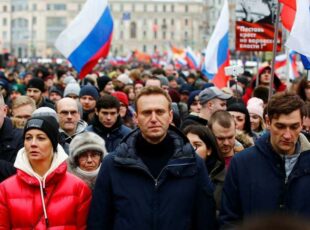The viral hashtag: why the Kremlin has taken up arms against Open Russia
The #Enough slogan doesn’t require any rational underpinning and wields huge potential; the realization of that potential is just a matter of time

by Kiril Rogov
Open Russia has succeeded in holding the protest event planned for April 29. And ahead of schedule, too. The “storm and stress” organised by the law enforcement agencies against Mikhail Khodorkovsky’s movement in the days prior to the scheduled date has been precipitated not so much by the threat of an “unauthorized rally” – one unlikely to be well attended – as by its main theme and hashtag: #Enough.
Heavy artillery
In the space of two days, the Kremlin has carried out searches and seizures at Open Russia’s Moscow offices and declared the London-based branch of the organisation to be “undesirable”, thereby putting into effect one of the most powerful repressive measures at its disposal. For the undesirable organizations law is quite possibly the most Stalinist of the concoctions devised by Russia’s current security apparatus.
The law stipulates that organisations can be declared undesirable by the prosecutor’s office – in other words, without recourse to court proceedings – and provides for the imposition of criminal sanctions, including imprisonment, on individuals found to be cooperating with them. The court does not establish that a given act constitutes a crime: whatever the prosecutor’s office deems to be a criminal act automatically becomes one. The court merely determines whether this act took place. This constitutes an inversion of law enforcement whereby the court acquires – and formally so – the status of a technical authority affiliated with bodies of extra-judicial prosecution.
The sheer severity of the regime’s response to Open Russia’s impending rally can without doubt be attributed principally to the fact that, in the Kremlin’s eyes, the aforementioned hashtag and the calls for Putin to refrain from seeking another presidential term pose a greater threat than Navalny’s ducks and trainers. The #Enough slogan doesn’t require any rational underpinning and wields huge viral potential. It’s clear that the realization of that potential – or, otherwise put, the coming to fruition of the slogan (bearing in mind the simple truth that Putin has been in power for eighteen years) – is just a matter of time. The time period in question, however, may prove rather protracted, and the battle over this period is becoming the primary focus of the presidential campaign.

Meting out a severe response in this case is important to the Kremlin for another reason, too: it will serve as a kind of counterweight to the events of March 26. Navalny managed to conduct a mass protest event without the authorities’ permission, and the regime, for its part, lacked the nerve to deal with the ensuing situation in the harshest possible way. This must now be counterbalanced by decisive action against Open Russia and the launching of criminal cases against individuals who took part in the rally on March 26.
In general, the discrepancies between the two oppositional strategies – Navalny’s and Open Russia’s – are very revealing. Navalny, whose objective was to get the maximum possible number of people out onto the streets, set store by a slogan that the Kremlin didn’t regard as all that injurious. And indeed, the regime didn’t deploy the heavy artillery of its repressive machine for the sake of Dmitry Medvedev. But in the eyes of Open Russia, which lacks the clout and popularity enjoyed by Navalny, it seemed apposite, strategy-wise, to adopt a radical slogan because this would amplify the effect of the impending rally – regardless even of how well-attended it might be.
Provocation of the “Maidans”
The Kremlin’s harsh response to the Open Russia slogan suggests once again that Putin’s presidential campaign cannot proceed by inertia in a scenario favourable for him, as was most likely envisaged at the start of the year. To buy time against the Open Russia slogan, Putin will need to execute a series of strong moves that would neutralise its viral potential.
Meanwhile, the foreign policy agenda that allowed the Kremlin to stay afloat for most of the current presidential term has now clearly worn itself out. Within Russia, people have grown weary of the regime’s geopolitical adventures and no longer regard them as “victories”; the West, meanwhile, has in large part adapted to the Kremlin’s foreign policy tactics, with international public opinion of Putin now more or less cemented.
Economic optimism, which the new economy minister seemed capable of inculcating in the president towards the end of last year, has proved premature. The key figure for the first quarter of 2017 – 0.4% growth – isn’t exactly a great banner under which to fight for re-election. Such a weak, technical growth figure only serves to demonstrate that the economy still hasn’t entered a recovery phase in the wake of the recession.
The Kremlin-orchestrated competition of economic programmes for Putin’s new term has devalued the very idea of a breakthrough. There’s no money for large-scale “show” projects. Because “show” projects not only entail investments, they also entail considerable outlays to buy the loyalty of the bureaucratic corporations and oligarchic groups implementing these programmes. And, in conditions of limited budgets, such projects can actually generate social crises, as is likely to be the case with the “Khruschevka” apartment block demolition programme in Moscow.
A particular problem is posed by the level of repressiveness that the Kremlin has made such efforts to amplify in recent years. The governmental machine is primed for repression, which reduces its capacity to reach political settlements and prevent conflicts from escalating. At the same time, repression (as well as the regime’s proclivity for the use of force in foreign policy) raises the stakes when it comes to internal conflicts.
This is especially true of social conflicts. When these occur, repressions are highly likely to result in the politicisation of hitherto unpoliticised groups with limited, non-political demands. Local skirmishes and confrontations involving the Kremlin’s National Guard – with factory workers in Birobidzhan, for instance, or truck drivers in Dagestan – increase the political resonance of these episodes. Even the general brand of the National Guard is now beginning to work against the Kremlin, bringing a federal dimension to conflicts regarded as localised by protesters and society alike. Loosely speaking, the National Guard was concocted to suppress a Russian “Maidan”, and now it turns any event into a “mini-Maidan” simply by putting in an appearance.

Crisis as a project
Even in the absence of new negative economic trends, open hotbeds of resistance in the elites or a clear upturn in protest sentiments, the upcoming presidential campaign is beginning to look increasingly less predictable. As already mentioned, there’s almost no doubt that the Kremlin will attempt to counteract the emerging negative trend by means of a strong move designed to change the public agenda in a fundamental way. If the regime is to deal with the threat of viral hashtags, this move must be genuinely strong; as such, however, it will come with its own risks, and its consequences will – at the very least – be less than entirely predictable.
Over the course of the current presidential term, the Kremlin has adhered to the strategy of raising the stakes in the foreign policy arena. While allowing the regime to keep a lid on domestic problems in the short term, this strategy has come up against an impasse: namely, a combination of sanctions (with the concomitant partial isolation of the country) and prolonged economic stagnation. Now, faced with a series of political and economic challenges and the threat of viral politicization, the Kremlin is tempted to raise the stakes in domestic policy.
Generally, the mechanisms governing the development of political crises are enigmatic and highly eccentric. The American political scientist Daniel Treisman, for example, has suggested that, as a rule, the principal drivers of such crises – and the regime downfalls they precipitate – are not objective factors as such; rather, they’re driven by errors on the part of the regime itself: by incorrect situational assessments. The actions undertaken by the regime as a result of these miscalculations trigger unforeseen and uncontrollable developments.
In the early 2000s, it was fashionable to talk about the negative impact of electoral cycles on economic development: every election – so the theory went – served to generate an eruption of populism. In actual fact, the idea of “renewal” is – as regards social expenditure – a relatively cheap political commodity that a regular turnover of power allows to be used effectively time and time again. And, conversely, the regime’s irremovability is leading to a situation where the battle against viral hashtags is becoming more and more costly and destabilizing for society and the elites.
This article first appeared in RBC in Russian



